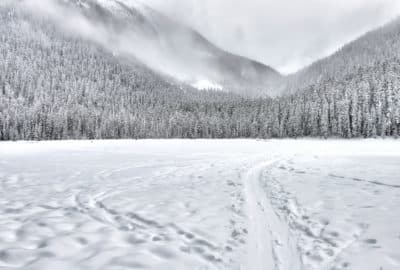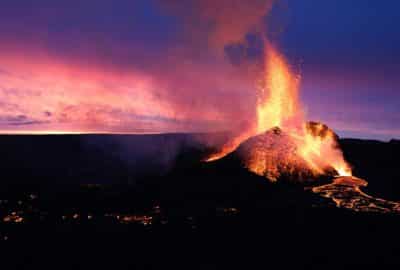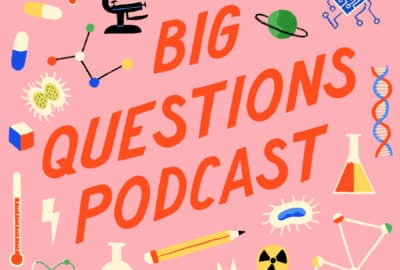How can satellites prevent mining disasters?
Tuesday 16th Nov 2021, 11.46am
Satellites have been orbiting our planet for the past few decades. We might be familiar with how they can be used to track weather, or beam television and phone signals around the world. But did you know, that by capturing images of the Earth outside the visible spectrum, they’re able to offer a unique perspective of the ground beneath our feet? They could even – as Earth observations specialist Maral Bayaraa tells us – provide a remote early warning system for an environmental catastrophe, dam collapse.
Emily Elias: Satellites have been taking images of the earth for the past few decades. But these aren’t just for pretty screensavers or to help us get from point A to B thanks to our mapping apps. These images can actually provide early warnings signs of the changes on the planet and help researchers track what’s actually happening in remote areas.
And on this episode of the Oxford Sparks Big Questions podcast, we are focusing on mines. And we are asking, how can satellites prevent mining disasters?
Hello, I’m Emily Elias, and this is the show where we seek out the brightest minds at the University of Oxford, and we ask them the big questions. And for this one, we have found a researcher who loves satellite images and mines.
Maral Bayaraa: Hi. My name is Maral Bayaraa, and at the moment I’m wearing quite a few hats, which is quite nice. So, I’m doing a DPhil, here at Engineering Sciences. And because my DPhil is supported by an industrial fellowship from the 1851 Royal Commission, I also have my one foot in industry, at the Satellite Applications Catapult, where I’m an earth observation specialist.
Emily: So, you spend a lot of time with satellites.
Maral: Yes. (Laughter)
Emily: How do you use satellite images to give us a picture of what’s going on in our world?
Maral: The way satellites work is that satellites are going around the earth, taking pictures and data. But they’re not just taking it in the kind of visible light in which our eyes see, but satellites are going around and taking pictures in the infrared part of the electromagnetic spectrum or in the microwave.
So, there are lots of different other wavelengths that our eyes can’t see but satellites can, and are taking images in. And that is quite significant because that means we can tell something about the characteristics of the ground, which our eyes just can’t see.
Emily: And that could be really handy when it comes to mining. Now, that doesn’t necessarily spring to the top of my mind, when I think of satellites in space, so how do you use them?
Maral: Yes, absolutely. So, there are many different uses of satellites in mining. There is basically a different approach for many different stages of the mining life cycle. For example, at the Satellite Applications Catapult, I have worked on projects for the very early mining life cycle, which is mineral exploration.
So, you can use satellite data taken in the infrared part of the electromagnetic spectrum to look at what minerals there are. So, you can do geological exploration to aid that part of the mine life cycle. And then later on, for the operational parts, you can use satellite data to monitor what’s happening.
And I guess, for my PhD, it’s very much using this particular type of satellite data, called radar satellite data, to understand how the stability of infrastructure- And then later on, you can do things like monitor how the environment is changing.
Emily: Let’s focus on the end life of mining. What kind of waste are we left with?
Maral: To get all the nice minerals and metals that we use in society, there has to be a mining operation. And things like copper, for example, and gold, it’s dug out, and then all that rock basically goes through a mineral processing.
And in that process of separating the waste material that we don’t need and the metals, often a lot of other chemicals are added. So, for gold, as you know, things like arsenic are added, right? So, other chemicals.
And then once you get all the nice metals, like the gold, the copper, out, the rest, which is often 99% of the material that’s left behind, plus all the other stuff that you have added, the other stuff that you have added is called the ‘tailing’. So, this is kind of mine waste in this slurry form, like this kind of mud consistency form, as a result of this mineral processing.
Emily: So, all that not so nice stuff that we don’t want getting into the environment. What do you do with all that mine waste slurry?
Maral: You have to do something with all this mine waste, right? One of the things that we do is put it behind these huge dams, called tailings dams. And the big headache of mining is mine waste, and tailings dams is one of the biggest ways of storing this mine waste.
Emily: And who is keeping an eye on all this waste and gross stuff?
Maral: In theory, it’s the mining company who is supposed to be looking after these tailings dams, right? But the problem is, often mining operations are on the scale of decades, right? So, often, it is multiple governments, multiple political systems. And it’s a very old profession as well, an old industry.
So, no-one really knows how many and where all the tailings dams of the world are, but there is an estimate that goes something like there are 18,000 tailings dams in the worlds and 3,500 of them are active tailings dams.
And there is a huge percentage of orphaned tailings dams. And these are basically, for one reason or another, the mining companies have left or they have become bankrupt or whatever. And now, it’s basically the government’s responsibility to look after these orphaned dams. And this is a very expensive- It’s like a global problem.
Emily: And these tailings dams, they aren’t a static thing, they move and shift over time, just like anything else does on this planet. So, when things go wrong, they go really wrong.
Maral: There have been a couple of really big Brazilian tailings dam disasters, one in 2019, by Brumadinho.
Emily: Yes, there are videos on YouTube and they are crazy. It looks like the ground just kind of gives up and liquefies, and then this torrid of red filth just unleashes a tidal wave over the ground.
Maral: The Brumadinho one, now I think it’s something like $7bn are being paid in remediation, right? But then all of this kind of environmental, long-term impact on the ecosystem and the habitats is just- It’s so difficult to measure.
Emily: So, your big idea is to try to use satellites to monitor these tailings dams, especially ones in remote areas. I mean, where are you going to start?
Maral: To begin with, I guess on the standard problem a little bit better. So, is there easy tell-tale signs from satellites that we can see before a failure happens, right?
For example, in the Australian dam in 2018, the Cadia tailings dam burst. There were two dams. The second dam actually caught the waste of the first dam, so there were no environmental implications, which is really nice.
Just before failure, in the area of the slump, there is some evidence to show that things are accelerating there. But then, is that acceleration of movement a robust enough signal to be an early warning system.
And then I’m also creating geotechnical numerical simulations of the tailings dams that collapsed. Which means we get to understand something about the specific mechanics of the movement and the way it collapsed. And once we understand the problem, how can we train a machine-learning algorithm to predict a collapse or predict a dangerous situation?
Emily: So, using AI, your plan is to work up a code that can measure these teeny-tiny signals and try and come up with an early detection system?
Maral: It’s a remote early warning system. This is one of the only ways in the future for many of these 18,000 tailings dams in the world to be able to actually monitor them at a frequency that might make them safer. Even in the most resource-poor countries, right?
Emily: I know it’s early days, but do you think this could predict mining disasters?
Maral: Prediction is ultimately about solving a very specific, deep problem by understanding the nuances of the data that matters. And this is what one of my friends, Tristan has said. And I really like that. Because you can’t just say, “Oh, AI now finds the…” It’s kind of like, to train the machine-learning algorithm, you have to show it many different examples of what a dangerous movement might look like.
Emily: So, how could this project transform the future of what mining looks like?
Maral: We are talking a lot about green technologies and the need to remain with the two degree commitments agreed in the Paris Agreement. So, for us to do that, an estimated three billion tons of metals will be required, to enable this energy transition.
And a key consequence of all these mining activities is the enormous volumes of mine waste produced, which are typically stored as tailings dams. So, given the toxicity of this mine waste and the consequence of structural failure, tailings dams are very high-risk geotechnical infrastructure.
And there is an urgent need to protect the surrounding communities, habitats, ecosystems, from another environmental disaster.
Emily: Okay. So, you’ve got world leaders up in Glasgow for COP26 and everybody is pretty anxious about the future of this planet, I think that’s fair to say. What message would you want to send to them about the mining industry?
Maral: It’s not a question of, how do we stop doing mining? It’s a matter of, how do we do responsible mining? How do we make sure that all our metals are coming from responsible sources?
So, yes, I guess it’s kind of like an analogous industry is the free-trade food industry, which is a really cool analogy. So, when you buy your technology, like your phone or your computer, how do we make sure that all the metals in there come from responsible sources, and also, the potential future risks and the environmental costs are accounted properly in it?
Emily: This podcast was brought to you by Oxford Sparks, from the University of Oxford, with music by John Lyons. And a special thanks to Maral Bayaraa.
Tell us what you think about this podcast. You can go to Twitter, tweet us @OxfordSparks. We are on Facebook, just search ‘Oxford Sparks’. And you can go to our website, oxfordsparks.ox.ac.uk.
I am Emily Elias. Bye for now.
Transcribed by UK Transcription.




